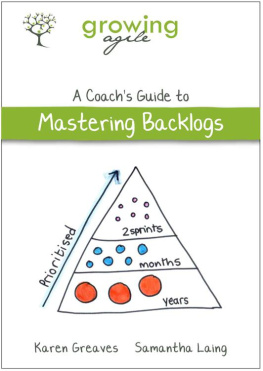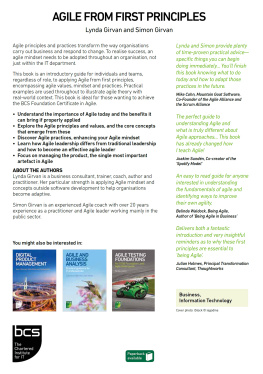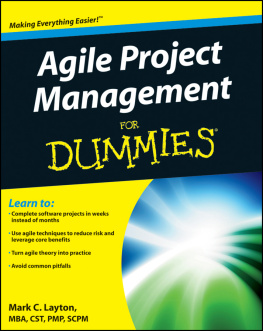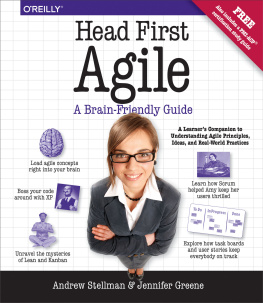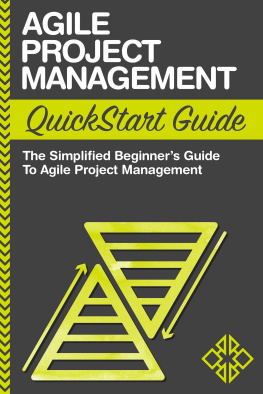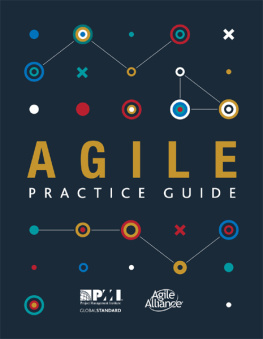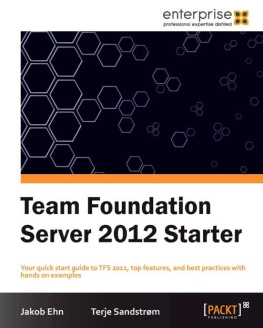Samantha Laing - Growing Agile: A Coachs Guide to Mastering Backlogs
Here you can read online Samantha Laing - Growing Agile: A Coachs Guide to Mastering Backlogs full text of the book (entire story) in english for free. Download pdf and epub, get meaning, cover and reviews about this ebook. year: 2015, publisher: Growing Agile, genre: Home and family. Description of the work, (preface) as well as reviews are available. Best literature library LitArk.com created for fans of good reading and offers a wide selection of genres:
Romance novel
Science fiction
Adventure
Detective
Science
History
Home and family
Prose
Art
Politics
Computer
Non-fiction
Religion
Business
Children
Humor
Choose a favorite category and find really read worthwhile books. Enjoy immersion in the world of imagination, feel the emotions of the characters or learn something new for yourself, make an fascinating discovery.
- Book:Growing Agile: A Coachs Guide to Mastering Backlogs
- Author:
- Publisher:Growing Agile
- Genre:
- Year:2015
- Rating:3 / 5
- Favourites:Add to favourites
- Your mark:
- 60
- 1
- 2
- 3
- 4
- 5
Growing Agile: A Coachs Guide to Mastering Backlogs: summary, description and annotation
We offer to read an annotation, description, summary or preface (depends on what the author of the book "Growing Agile: A Coachs Guide to Mastering Backlogs" wrote himself). If you haven't found the necessary information about the book — write in the comments, we will try to find it.
Growing Agile: A Coachs Guide to Mastering Backlogs — read online for free the complete book (whole text) full work
Below is the text of the book, divided by pages. System saving the place of the last page read, allows you to conveniently read the book "Growing Agile: A Coachs Guide to Mastering Backlogs" online for free, without having to search again every time where you left off. Put a bookmark, and you can go to the page where you finished reading at any time.
Font size:
Interval:
Bookmark:
This book is for sale at http://leanpub.com/MasteringBacklogs
This version was published on 2015-01-09

* * * * *
* * * * *
Thanks to all the business people we have coached and trained over the last few years. This book would not be the same without you.
Wed also like to thank Sharna Sammy for her fantastic cover designs for our Coachs Guide series.

Sam Laing (left) and Karen Greaves (right)
We are Sam Laing and Karen Greaves. We have worked in software our whole lives. With Type A personalities and a strong work ethic, we have both done our share of overtime on death march projects. Eventually we knew we had to find another way. Agile brought us together when we worked at a company trying to do Scrum for the first time.
In 2012, we took the plunge and started our own business, Growing Agile. Since then we have been doing the work that we are passionate about - introducing and improving agile. Best of all we have a positive impact on other peoples lives.
If we have one principle at Growing Agile it is continuous experimentation. We used this principle to figure out different ways to help Product Owners. This book represents our current thinking about how best to approach this.
As always, we love feedback, so dont hesitate to send us your thoughts via email .
As agile coaches we often find ourselves running workshops or training sessions with people we are coaching. We put a great deal of effort into creating the plans for these sessions to help the participants get value. Over the past 2 years we have collected a lot of these plans. This series is our way of sharing these workshop and training plans with other agile coaches to enable you to run similar workshops.
All the books in this are structured in a similar way, this section explains the concepts youll need to effectively use any of the books in the series. Weve put it here at the start of the book, so that if youve used any of the other books in the series you dont need to read through this again, its the same in each book.
Each chapter in these books includes a 4Cs plan. The technique comes from a training style called Training from the BACK of the room (TFTBOTR) developed by Sharon Bowman.
TFTBOTR is based on how adults learn and is focused on maximising learning and retention. TFTBOTR describes four parts that should be included in any training plan. These parts are known as the 4Cs and are described below.
- C1 Connections: To get participants to connect with each other and the trainers, and to connect participants to what they might already know about the topic
- C2 Concepts: Some facts and theoretical concepts about the topic
- C3 Concrete Practice: An activity or simulation to experience the topic
- C4 Conclusion: An opportunity for participants to evaluate what they have learned about the topic
Another important part of TFTBOTR is making sure you use a variety of methods to keep people engaged. Read more about it in this article on the Six Trumps by Sharon Bowman.
After using this technique extensively for training, we started using it for workshops as well. The 4Cs plan is a great way to weave new information or a technique into a working meeting. You can use C2, the concept stage to talk briefly about a technique, then spend time in C3, getting practice on using the technique on your work items.
 | Note Occasionally it makes sense to swap the order of the C2 and C3. For some topics it is better for people to experience what you are talking about with Concrete Practice first, and then for you to teach the theory. This is especially true if you have a great game or simulation to illustrate the point. When we do this we just put the C3 in the C2 block of the template, and vice versa. |
We drive all our workshops and courses from these 4Cs plans. If you usually train from slides this might take time to get used to. We print out the 4Cs plans and refer to them during the course or workshop to see whats up next and if we are on track.
We have created our own template for the 4Cs plans. The template can be found in the Coach Toolkit for each book. Use it to create your own training plans.

Here is a short overview to help you understand the template.
- The box in the top left corner is for the name of the topic.
- The big clock icon gives the time for the entire plan; the smaller clock icons in each quadrant gives the time needed for that section.
- The box in the top right corner has a space for you to enter the time for a section. For example 9:00 to 9:30 am. This helps you stay on track during the training. These are not filled in on the training plans we provide. We suggest you fill them in when you have planned your training.
- The rest of the page has a quadrant for each of the 4Cs. C1 covers connection activities. C2 is for concepts and is quite often a short lecture. C3 is for concrete practices or some activity to help people understand what they have learned. C4 contains conclusions of how people might apply the learning.
- At the bottom of each quadrant you can circle what the participants are doing in each section: Move, Speak, Draw, Listen, Write. This helps ensure that you have sufficient variety in each topic.
Each chapter contains the following:
- overview of the topic covered in the 4Cs plan
- 4Cs training plan
- notes on delivering each 4Cs part
- slides used for the topic
- exercises used for the topic.
Once you have a feel for what each topic covers you can structure your own workshops using one or more topics depending on your goal and time available.
Each book in the series includes a Coach Toolkit which you can download from website. The toolkit contains the following items.
Training plans: PDF combining all the 4Cs training plans. You should print these out and use them when you train. You will notice that these plans are handwritten, we find them much easier to create and change by hand than if they are typed.
Slides: PPTX containing all the slides used. These slides were created using scanned hand drawings. Some slides have been edited to allow you to insert your own details. For these slides we used Lauren C. Brown font as it closely matches the handwriting on the other slides. If you prefer not to use slides you can recreate these images on flipcharts.
4C template: Use this blank template to create your own 4Cs plans on new topics.
Agreement Cards: PDF of cards used in the Getting Started chapter of each book. We printed and laminated them and use them in nearly every workshop we run. You dont need to use all the cards each time. Look through the cards before each workshop and decide which agreements are appropriate. The cards help make sure you dont forget anything important.
Font size:
Interval:
Bookmark:
Similar books «Growing Agile: A Coachs Guide to Mastering Backlogs»
Look at similar books to Growing Agile: A Coachs Guide to Mastering Backlogs. We have selected literature similar in name and meaning in the hope of providing readers with more options to find new, interesting, not yet read works.
Discussion, reviews of the book Growing Agile: A Coachs Guide to Mastering Backlogs and just readers' own opinions. Leave your comments, write what you think about the work, its meaning or the main characters. Specify what exactly you liked and what you didn't like, and why you think so.

